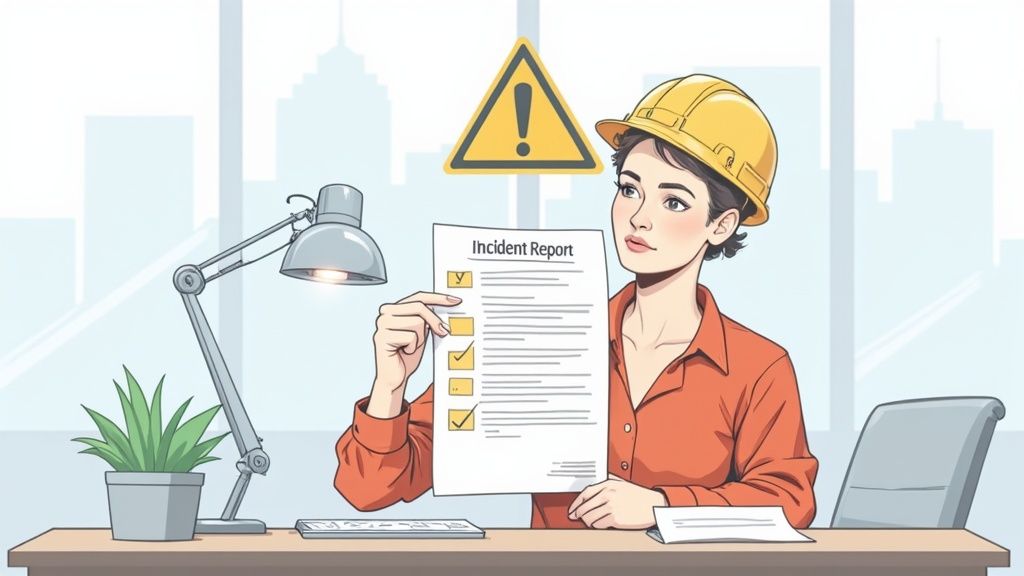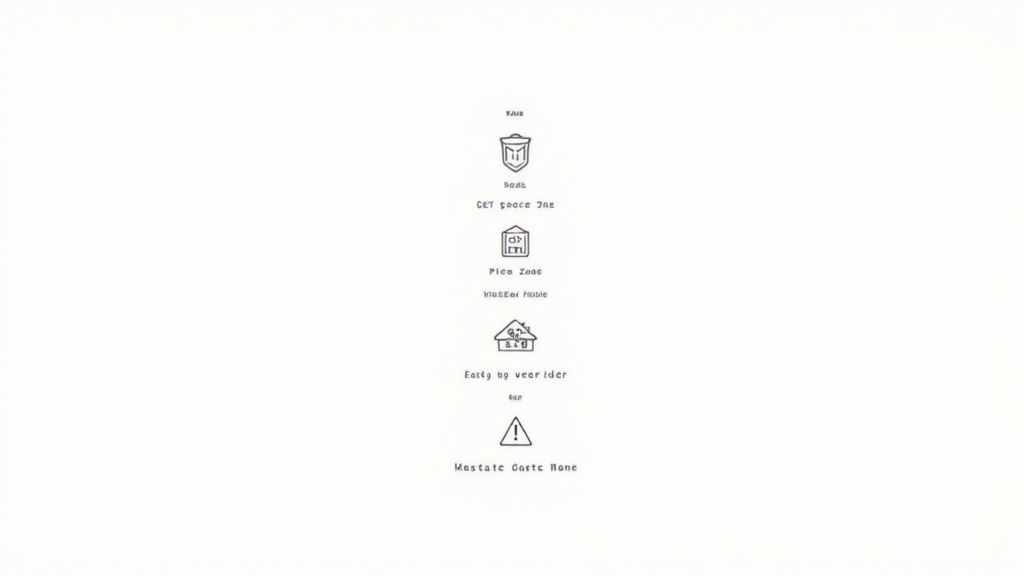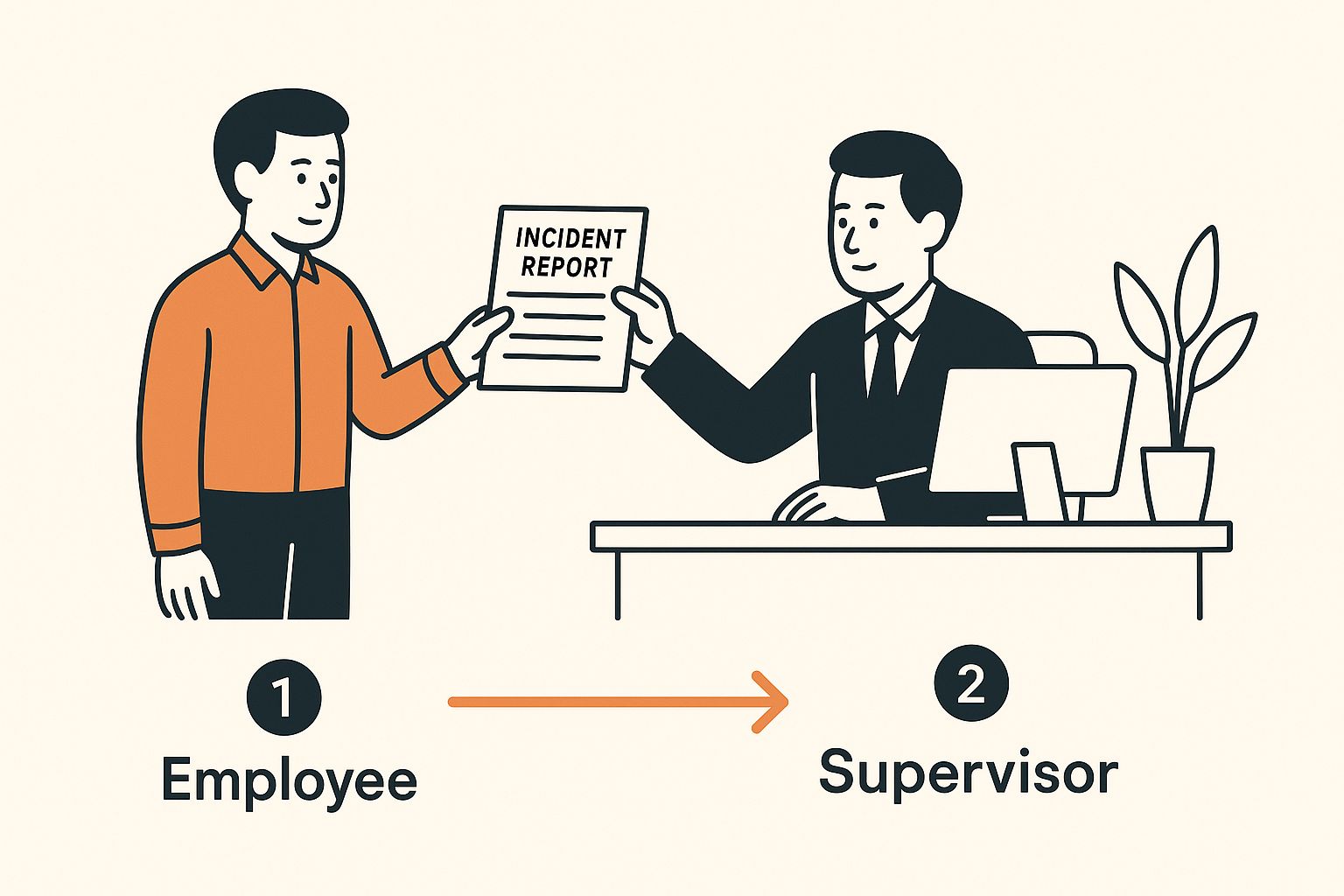A work incident report is a formal document that captures the details of any injury, illness, near-miss, or accident that happens on the job. It’s the official, factual account of what happened, who was involved, and the immediate actions taken.
Think of it as the foundational record that helps everyone, from the site supervisor to the safety committee, understand exactly what occurred.
Why Accurate Incident Reporting Is Non-Negotiable

It’s easy to dismiss a work incident report as just another piece of paperwork, but its real value lies in preventing the next incident. An accurate report is a critical tool for figuring out precisely what went wrong so it doesn't happen again. The goal here isn't to assign blame; it's to collect the facts while they're still fresh.
This factual record becomes the bedrock for any meaningful follow-up investigation. Without a clear and detailed account written shortly after the event, important details get lost, memories fade, and the chance to identify the true root cause slips away.
The Practical Reasons for Good Reporting
A well-written report delivers direct, practical benefits that go way beyond simple compliance. It helps you pinpoint specific risks and hazards in your work environment that might have been overlooked. For instance, if multiple reports mention slippery floors in a particular area of a manufacturing plant, it flags a clear problem that needs a real solution.
These documents are absolutely essential for:
- Identifying Trends: Consistent reporting can reveal patterns you’d otherwise miss, like a specific machine that keeps malfunctioning or a certain task that causes frequent minor injuries.
- Justifying Changes: A collection of reports provides the hard evidence needed to justify spending on new equipment, modifying a process, or rolling out extra training.
- Improving Processes: The details tucked away in a report can shine a light on flaws in existing procedures, leading to practical improvements that make the workplace safer for everyone.
A report is a snapshot in time. Its job is to capture the scene and the sequence of events objectively. This data is what allows managers and safety officers to make informed decisions instead of just guessing what the problem is.
Legal and Compliance Requirements
Beyond the practical side of things, there are serious legal reasons to get incident reporting right. In Australia, workplaces are required by law to record and, in serious cases, report workplace incidents to regulatory bodies like Safe Work Australia.
Failing to do so can lead to significant fines and legal headaches. An accurate work incident report serves as your official record, proving that you took the event seriously and followed the correct procedures. It protects both the employees and the company by creating a transparent account of what took place.
This documentation is crucial during any external investigation or for workers' compensation claims. You can learn more about how a formal incident management system helps organise these records for compliance and analysis, taking the guesswork out of the equation.
What to Document Immediately After an Incident

In the minutes following an incident, the absolute first priority is always the wellbeing of your people. But once the area is safe and first aid has been administered, your focus has to shift fast: it’s time to capture information.
The details you gather on the spot are gold. They form the most accurate and untainted part of any work incident report you’ll write later.
Why the rush? Because memories fade and get fuzzy, fast. The scene itself can be altered in minutes. Your job is to create a factual snapshot of what was, not what people remember it being a few hours or even days later. This initial data is the bedrock for figuring out what actually happened.
The hard truth is that workplace incidents are a persistent threat. Across Australia, work-related traumatic injuries have caused over 1,850 deaths in the last decade alone. Worse, recent statistics show a worrying 13% year-on-year jump in fatalities, mainly from vehicle incidents, being hit by moving objects, and falls from height. This really drives home why getting the details right is so critical for preventing the next one. You can dig deeper into these Australian workplace safety statistics to see the trends for yourself.
The Core Four Ws
Before you get bogged down in the details, lock down the absolute basics. These are the non-negotiables that give context to everything else.
- Who was involved? Get a list of everyone directly caught up in the incident: names, job titles, and their departments. Just as importantly, jot down the names of anyone who saw it happen.
- What happened? Keep it simple. A brief, one or two-sentence summary is all you need for now. This isn’t the full story yet. Think: "Forklift backed into racking in aisle three," or "Team member reported back strain after lifting a 20kg box."
- Where did it happen? Be specific. "The warehouse" isn't enough. Go for something like, "Bay 14 of the main warehouse, right next to the northern packing station." The more precise, the better.
- When did it happen? Nail down the exact date and time. If no one’s certain, get the closest possible estimate and make a note that it's an approximation.
Your immediate notes don't need to be a masterpiece. They just need to be factual. Use your phone's notepad or carry a small notebook. Speed and accuracy are what count right now.
Grab Your Phone and Capture the Scene
Photos and videos are your best friends here. They show the scene as it was, with no bias or interpretation. Don't worry about a fancy camera; your phone will do the job perfectly.
Take way more photos than you think you’ll need, and from different angles. Start with wide shots to establish the general area, then move in for close-ups of anything relevant: damaged equipment, spills on the floor, the final position of objects. A pro tip is to snap a picture of any equipment settings or digital displays if they could be a factor.
This visual proof helps investigators piece together the environmental conditions and the physical layout. It provides an objective record that words alone can never fully capture.
Documenting Conditions and Key Actions
Now, take a good look at the environment. What were the conditions like when it happened? Scribble down anything that seems remotely relevant, no matter how minor it might seem.
Look out for things like:
- Environmental Conditions: Was the lighting dim? Was the floor wet, oily, or cluttered? Was it unusually noisy, hot, or cold?
- Equipment Status: What was the state of the gear involved? Note if safety guards were missing, if there was visible damage before the incident, or if any warning lights were flashing.
- Actions Leading Up: Get a clear picture of the specific task the person was doing right before it all went wrong. For instance, "The employee was walking down the main stairs while carrying a box, obstructing their view," or "The operator was in the middle of adjusting the feed rate on the CNC lathe."
It’s also a good idea to get some initial thoughts from witnesses, but be careful not to lead them. Just ask them, "Tell me what you saw in your own words." Write down their quotes directly or, if you have permission, hit record on your phone. Capturing these immediate, unfiltered observations is vital for building a robust work incident report.
How to Structure Your Report for Total Clarity
A messy, confusing report is a useless one. It slows down investigations, creates headaches, and makes it incredibly difficult to figure out what actually happened. On the other hand, a well-organised work incident report lays out the facts cleanly, guiding the reader from the basics to the full story without any guesswork.
The trick is to follow a standard structure that covers all the critical information in a logical sequence. Think of it like you're building a case file: each section adds another layer of factual detail, creating a complete and easy-to-understand picture of the event. Getting this organised approach right from the start means you're far less likely to miss something important.
This infographic shows the simple flow of information from the employee to the supervisor, which is the first step in the official reporting process.

As the visual highlights, a clear hand-off of a properly structured report is what kicks off any meaningful follow-up actions.
Start with the Essential Details
Every single report needs to begin with the basics. This section gives immediate context and is usually the most straightforward part to complete. It acts as the "cover sheet" for the whole document, giving anyone who picks it up a quick snapshot of the who, what, where, and when.
Make sure you nail these core details right at the top:
- Date and Time of Incident: Be as precise as you can. If you're not 100% sure, give your best estimate and make a note that it's an approximation.
- Location of Incident: Get specific here. Instead of just "Loading Bay," write something like "Loading Bay 3, near the hydraulic lift." Details matter.
- People Involved: List the full names and job titles of everyone directly involved, especially the person who was injured.
- Witnesses: Don't forget to include the names and contact details of anyone who saw what happened.
This initial data is the foundation of the report. Getting it right ensures the document is filed correctly and can be easily pulled up for future reference or investigation.
The Chronological Narrative
Now we get to the heart of the report: explaining exactly what happened. Your goal here is to provide a step-by-step account of the events as they unfolded, in chronological order. This is absolutely not the place for opinions, assumptions, or pointing fingers. Stick to the observable facts.
A good narrative is written in plain, direct language. When you write this section, imagine you’re a camera just recording the scene. Describe what you saw and heard, nothing more.
The most effective narratives are built on a clear timeline. Start just before the incident to set the scene, describe the incident itself, and then detail the immediate aftermath. This structure leaves no room for confusion.
For really complex incidents, especially those that will land on a senior manager's desk, clarity is everything. When you're structuring a report for high-level stakeholders, knowing how to write a perfect executive summary can be a game-changer for getting the critical information across quickly.
To give you a clearer idea, here's a table breaking down the key sections you'll find in a standard report.
Key Sections of a Work Incident Report
This table outlines the essential information needed for each part of a standard incident report, helping you ensure nothing is overlooked.
| Section | What to Include | Example Note |
|---|---|---|
| Basic Information | Date, time, specific location, names/titles of involved parties, and witnesses. | "14 March 2024, 10:15 AM, Warehouse Section B, Aisle 4." |
| Incident Description | A factual, chronological account of events leading up to, during, and after the incident. | "Operator was reversing forklift. At 10:15 AM, the rear of the forklift made contact with racking." |
| Injuries/Damage | Detailed description of any harm to people or property. Be specific about the type and extent. | "2-inch laceration on left forearm. Racking shelf bent; three boxes of stock crushed." |
| Immediate Actions | What was done right after the incident? (e.g., first aid, area secured, supervisor notified). | "First aid administered on-site. Area cordoned off with safety cones. Shift supervisor notified." |
| Analysis (Optional) | A preliminary look at potential contributing factors. Stick to facts, not blame. | "Wet floor in the area noted, though warning signs were not present." |
| Recommendations | Suggestions for corrective actions to prevent a recurrence. | "Recommend installing anti-slip flooring and reviewing sign placement procedures." |
Filling out each of these sections thoroughly provides a robust, factual basis for any subsequent investigation or safety improvements.
Describing Injuries and Damage
After the narrative, you need a dedicated section to document the consequences. This means detailing any injuries to people or damage to property and equipment. Precision here is non-negotiable.
For injuries, describe what you observed:
- Type of Injury: Use clear, simple terms like "laceration," "bruise," or "burn."
- Body Part Affected: Pinpoint the exact location, like "deep cut on the back of the left hand."
- Severity: Note whether it was minor (needing a simple bandage) or serious enough to require professional medical attention.
Be just as detailed with property damage. Instead of a vague "the forklift was damaged," write "the forklift's right-side fork was bent at a 30-degree angle, and the front headlight was shattered." This level of detail is invaluable for organising repairs, assessing costs, and informing the investigation.
Using dedicated incident management software can make a huge difference here, helping you organise these details effectively and ensuring nothing gets missed.
Writing a Factual and Objective Narrative
This is the heart of your incident report. It’s where you lay out the story of what happened, but honestly, it's also where things tend to go off the rails. The single biggest mistake I see is people letting their opinions, emotions, and assumptions bleed into the text.
Your job here is to be a reporter, not a judge. When you stick to the facts, you create a credible, useful document. You want to avoid any language that points fingers or makes a guess about what someone was thinking or feeling. The goal is to describe actions and outcomes with a neutral, almost detached tone, building a clear sequence of events.
Use Objective Language
The difference between subjective and objective language is everything in a report. Subjective statements are based on feelings or beliefs. Objective statements are based on observable facts. Getting this right is what makes a report worth the paper it’s written on.
Here’s a quick comparison to show you what I mean:
Subjective: "The operator was being careless and wasn't paying attention."
Objective: "The operator was not wearing safety gloves and was looking at their phone."
Subjective: "He recklessly drove the forklift too fast."
Objective: "The forklift was travelling at 15 km/h in a 10 km/h zone."
The objective statements give an investigator concrete, verifiable information. The subjective ones are just opinions that can’t be proven and will immediately undermine the integrity of your report.
Think of it this way: Write down what a security camera would have recorded. A camera sees actions, positions, and conditions. It doesn't see carelessness, laziness, or intent. Stick to what the camera would see.
Include Even Minor Details
It’s so easy to dismiss the small stuff, but those minor details can be the key to an entire investigation. Something that seems trivial in the moment could be a major contributing factor.
Did a warning alarm sound just before the incident? Was the lighting in the area a bit dimmer than usual? Was there a small, unreported spill on the floor from an earlier shift?
These little observations add crucial context and help investigators piece together the full picture. My rule of thumb is, when in doubt, write it down. It’s always better to have too much factual information than not enough.
This is more important than ever as we start to recognise a broader range of workplace hazards. A recent Australian report revealed that two-thirds of workers have faced customer aggression, and a staggering 76% don't feel entirely safe to make mistakes at work. With issues like high job demands, conflict, and bullying now being identified as top psychosocial hazards, our reports need to capture more than just physical accidents. You can find more insights about these workplace safety gaps and trends.
If you’re struggling to keep the narrative tight and factual, learning how to summarize information effectively is a great skill to develop. It helps you boil down complex events into clear, concise points for your report.
And one last tip: wherever possible, use direct quotes from witnesses. Put their exact words in quotation marks. This keeps their account pure and clearly separates what they said from your own factual observations.
Common Reporting Mistakes That Cause Problems
Knowing what not to do is just as important as knowing what to do. Even a well-intentioned work incident report can become completely useless if it falls into a few common traps. These simple mistakes can stall investigations, muddy the facts, and get in the way of making real, necessary improvements on site.
One of the biggest culprits is simply waiting too long. The human brain is terrible at recalling specifics after the fact. Details fade fast, and a report written days after an event is nowhere near as reliable as one completed within 24 hours. Any delay just makes it harder for everyone to piece together an accurate timeline of what actually happened.
Vague Language and Missing Details
Another classic problem is using wishy-washy language. A report stating "the worker was injured" is almost useless. What does that even mean? Compare that to "the worker received a 3cm cut on their right forearm." Now we're getting somewhere. Specificity is everything.
Similarly, leaving out what seem like minor details can create massive gaps in the story. Forgetting to mention the floor was wet or a machine guard was out of place might not seem like a big deal at the time, but these are often the crucial puzzle pieces needed to understand what went wrong.
The goal is to paint a clear, factual picture for someone who wasn't there. If your report leaves the reader with more questions than answers, it has failed. A good report closes loops, it doesn't create new ones.
Guessing at the cause of an incident is another trap people fall into. Stick to what you saw and what you know. Never write something like "he wasn't paying attention" or "the machine must have malfunctioned." That’s speculation.
Instead, document the observable facts: "the operator was looking away from the task," or "the machine made an unusual grinding noise." Let the investigation team connect the dots; your job is to give them the right dots to begin with.
The Cost of Inaccurate Reporting
In high-risk industries, the consequences of poor reporting are deadly serious. In 2023, Australia recorded 200 workplace fatalities, with vehicle incidents and falls from height being major contributors.
The data, which you can read more about via the Australian Institute of Health & Safety, shows that the construction, manufacturing, and transport sectors are where most of these tragedies occur. This just hammers home how critical accurate reporting is for spotting and fixing deadly risks before they claim another life.
Finally, failing to properly review and sign the document calls its validity into question. That final check is your chance to ensure everything is correct and complete, making the report a credible, official record. Avoiding these common errors ensures your work incident report becomes a genuinely useful tool for prevention.
It's also essential to understand the difference between a full-blown incident and a close call. You can learn more by checking out our guide on the importance of reporting a near miss incident.
Got Questions About Incident Reports? We've Got Answers
Even with the best instructions, you're bound to have questions when it comes time to fill out an incident report. It's only natural. Let's tackle some of the most common ones we hear from teams on the ground in construction and manufacturing.
Getting these details right helps you create a factual, useful document that actually makes a difference.
How Soon Do I Need to Write the Report?
The golden rule is: write it as soon as you possibly can. Ideally, you want to get everything down within 24 hours of the incident. The longer you wait, the more critical details start to fade for you and any witnesses.
Memories get fuzzy fast. What seemed crystal clear an hour after an event can become a total blur a day later. Prompt reporting isn't just about accuracy, either. It’s about speed. It means the right people can take immediate action, whether that's securing an area, inspecting equipment, or kicking off an investigation.
What if I Was the Only Person Who Saw It?
If you're the sole witness, your report suddenly becomes the single most important record of what happened. This is where your thoroughness really counts. You have to stick to the facts, no exceptions.
When it's just you, make sure you:
- Document the sequence of events exactly as you saw them unfold.
- Clearly state in the report that no one else was present.
- Fight the urge to guess or speculate. Only include what you actually saw and heard.
Your objective account is the foundation for everything that follows.
A report from a single, credible witness is far more valuable than one clouded by second-hand information or guesswork. Be confident in what you observed and get it down on paper clearly.
Should I Include What I Think Caused the Incident?
In a word: no. Your job is to be a reporter of facts, not a detective. It's crucial to leave out personal opinions, theories, or any conclusions about why you think the incident happened. That’s a job for the investigation team.
Stick purely to what you can observe. For example, instead of writing, "He slipped because someone was careless and left a spill," you should write, "The employee slipped in a 2-foot wide puddle of clear liquid." Let the facts speak for themselves.
What Happens After I Submit the Report?
Once you've handed it in, the report typically goes to a supervisor, manager, or the safety officer for review. It officially kicks off any formal investigation that might be needed.
Depending on how serious the event was, your report could trigger a full-scale investigation to uncover the root cause and figure out what corrective actions are needed. It also gets filed as an official legal and compliance record, which is vital for things like audits and insurance claims down the line.
Filling out incident reports properly is a non-negotiable part of the job, but wrestling with paper forms or clunky spreadsheets is a huge time-waster. Safety Space offers a fully customisable platform to handle all your health and safety management, from incident reporting to compliance tracking. Find out how you can ditch the outdated systems and get real-time oversight by visiting https://safetyspace.co.
Ready to Transform Your Safety Management?
Discover how Safety Space can help you build a safer, more compliant workplace with our comprehensive safety management platform.
Book a Free DemoRelated Topics
Safety Space Features
Explore all the AI-powered features that make Safety Space the complete workplace safety solution.
Articles & Resources
Explore our complete collection of workplace safety articles, tools, and resources.
